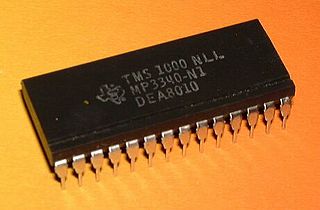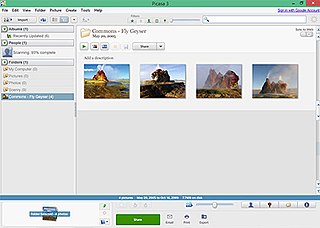
Advanced Micro Devices, Inc. (AMD) is an American multinational semiconductor company based in Santa Clara, California and Austin, Texas that develops computer processors and related technologies for business and consumer markets. While initially it manufactured its own processors, the company later outsourced its manufacturing, a practice known as fabless, after GlobalFoundries was spun off in 2009. AMD's main products include microprocessors, motherboard chipsets, embedded processors and graphics processors for servers, workstations and personal computers, and embedded systems applications.

A microprocessor is a computer processor that incorporates the functions of a central processing unit on a single integrated circuit (IC), or at most a few integrated circuits. The microprocessor is a multipurpose, clock driven, register based, digital integrated circuit that accepts binary data as input, processes it according to instructions stored in its memory, and provides results as output. Microprocessors contain both combinational logic and sequential digital logic. Microprocessors operate on numbers and symbols represented in the binary number system.

Open Graphics Library (OpenGL) is a cross-language, cross-platform application programming interface (API) for rendering 2D and 3D vector graphics. The API is typically used to interact with a graphics processing unit (GPU), to achieve hardware-accelerated rendering.

Centrino is a brand name of Intel Corporation which represents its Wi-Fi and WiMAX wireless computer networking adapters. Previously the same brand name was used by the company as a platform-marketing initiative. The change of the meaning of the brandname occurred on January 7, 2010.

x86-64 is the 64-bit version of the x86 instruction set. It introduces two new modes of operation, 64-bit mode and compatibility mode, along with a new 4-level paging mode. With 64-bit mode and the new paging mode, it supports vastly larger amounts of virtual memory and physical memory than is possible on its 32-bit predecessors, allowing programs to store larger amounts of data in memory. x86-64 also expands general-purpose registers to 64-bit, as well extends the number of them from 8 to 16, and provides numerous other enhancements. Floating point operations are supported via mandatory SSE2-like instructions, and x87/MMX style registers are generally not used ; instead, a set of 32 vector registers, 128 bits each, is used. In 64-bit mode, instructions are modified to support 64-bit operands and 64-bit addressing mode. The compatibility mode allows 16- and 32-bit user applications to run unmodified coexisting with 64-bit applications if the 64-bit operating system supports them. As the full x86 16-bit and 32-bit instruction sets remain implemented in hardware without any intervening emulation, these older executables can run with little or no performance penalty,
while newer or modified applications can take advantage of new features of the processor design to achieve performance improvements. Also, a processor supporting x86-64 still powers on in real mode for full backward compatibility.

Picasa is a discontinued image organizer and image viewer for organizing and editing digital photos, plus an integrated photo-sharing website, originally created by a company named Lifescape in 2002. In July 2004, Google acquired Picasa from Lifescape and began offering it as freeware. "Picasa" is a blend of the name of Spanish painter Pablo Picasso, the phrase mi casa and "pic" for pictures.
Nonstop is a series of server computers introduced to market in 1976 by Tandem Computers Inc., beginning with the NonStop product line, which was followed by the Hewlett-Packard Integrity NonStop product line extension. Because NonStop systems are based on an integrated hardware/software stack, HP also developed the NonStop OS operating system for them.
In computing, x86 virtualization refers to hardware virtualization for the x86 architecture. It allows multiple operating systems to simultaneously share x86 processor resources in a safe and efficient manner.

A universal binary is, in Apple parlance, an executable file or application bundle that runs natively on either PowerPC or Intel-manufactured IA-32 or Intel 64-based Macintosh computers; it is an implementation of the concept more generally known as a fat binary.
Apple's Intel transition was the process of changing the central processing unit (CPU) of Macintosh computers from PowerPC processors to Intel x86 processors. The transition became public knowledge at the 2005 Worldwide Developers Conference (WWDC), when Apple's CEO Steve Jobs made the announcement that the company would make a transition from the use of PowerPC microprocessors supplied by Freescale and IBM in its Macintosh computers, to processors designed and manufactured by Intel, a chief supplier for most of Apple's competitors.
Intel Turbo Memory is a technology introduced by Intel Corporation that uses NAND flash memory modules to reduce the time it takes for a computer to power up, access programs, and write data to the hard drive. During development, the technology was codenamed Robson. It is supported by most of the Core 2 Mobile chipset series, but not by the newer Core i Series mobile chipsets.
Intel vPro technology is an umbrella marketing term used by Intel for a large collection of computer hardware technologies, including Hyperthreading, Turbo Boost 3.0, VT-x, VT-d, Trusted Execution Technology (TXT), and Intel Active Management Technology (AMT). When the vPro brand was launched, it was identified primarily with AMT, thus some journalists still consider AMT to be the essence of vPro.
Common Building Block (CBB) was a set of technical standards for laptop components introduced by Intel in 2005, and adopted by some manufacturers.

A mobile Internet device (MID) is a multimedia-capable mobile device providing wireless Internet access. They are designed to provide entertainment, information and location-based services for personal or business use. They allow 2-way communication and real-time sharing. They have been described as filling a niche between smartphones and tablet computers.

OpenCL is a framework for writing programs that execute across heterogeneous platforms consisting of central processing units (CPUs), graphics processing units (GPUs), digital signal processors (DSPs), field-programmable gate arrays (FPGAs) and other processors or hardware accelerators. OpenCL specifies programming languages for programming these devices and application programming interfaces (APIs) to control the platform and execute programs on the compute devices. OpenCL provides a standard interface for parallel computing using task- and data-based parallelism.

The Macintosh is a family of personal computers designed, manufactured, and sold by Apple Inc. since January 1984. The original Macintosh was the first mass-market personal computer that featured a graphical user interface, built-in screen and mouse. Apple sold the Macintosh alongside its popular Apple II family of computers for almost ten years before they were discontinued in 1993.

AMAX Engineering Corporation is a privately held technology company based in Fremont, California. Founded in 1979, AMAX specializes in application-tailored Cloud, Data Center, Deep Learning, open architecture platforms, HPC and OEM solutions.
ZiiLABS is a global technology company, producing a line of media-oriented application processors, reference platforms and enabling software in a series of platforms named ZMS. These are designed to create products that target a range of low-power consumer electronics and embedded devices, including Android-based phones and tablets.
Bonnell is a CPU microarchitecture used by Intel Atom processors which can execute up to two instructions per cycle. Like many other x86 microprocessors, it translates x86 instructions into simpler internal operations prior to execution. The majority of instructions produce one micro-op when translated, with around 4% of instructions used in typical programs producing multiple micro-ops. The number of instructions that produce more than one micro-op is significantly fewer than the P6 and NetBurst microarchitectures. In the Bonnell microarchitecture, internal micro-ops can contain both a memory load and a memory store in connection with an ALU operation, thus being more similar to the x86 level and more powerful than the micro-ops used in previous designs. This enables relatively good performance with only two integer ALUs, and without any instruction reordering, speculative execution or register renaming. A side effect of having no speculative execution is invulnerability against Meltdown and Spectre.











